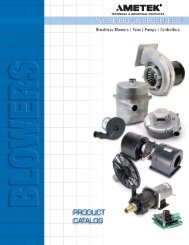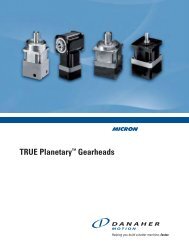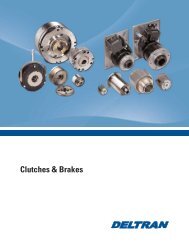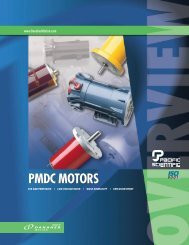Profile Rail Linear Guides
Profile Rail Linear Guides
Profile Rail Linear Guides
Create successful ePaper yourself
Turn your PDF publications into a flip-book with our unique Google optimized e-Paper software.
<strong>Profile</strong> <strong>Rail</strong> <strong>Linear</strong> <strong>Guides</strong><br />
Mean Dynamic Load<br />
In applications with loads of varying magnitude, a mean<br />
dynamic load should be calculated.<br />
Where :<br />
F EQ1 …F EQn = equivalent dynamic load for distances d1<br />
through dn<br />
D = total distance of stroke = d1+d2…+dm<br />
P = 3 (linear guides w/Ball Type Rolling Elements)<br />
10/3 (linear guides w/Roller Type Rolling Elements)<br />
Load Ratings for Rolling Element <strong>Guides</strong><br />
Dynamic Load Rating, C, and Travel Life<br />
The dynamic load rating, C, is the load at which when<br />
applied will yield the rated travel life. The rated travel life,<br />
Lr, for most linear guides is 100 km for metric products and<br />
4 million inches for inch products (the rated travel life is<br />
listed on the page with the dynamic load rating). For a given<br />
applied load, P, the dynamic load rating and rated travel<br />
life are used to calculate the travel life using the following<br />
load / life equation :<br />
L = (C/F EQ ) n x L r<br />
Where :<br />
L = calculated travel life<br />
C = dynamic load rating<br />
F EQ = equivalent applied load<br />
n = 3 for ball guides, 10/3 for roller guides<br />
= rated travel life<br />
L r<br />
Some manufacturers dynamic load ratings are based upon<br />
a 50 km life. To compare dynamic load ratings for guides<br />
with a 50 km rated life with a 100 km life, divide the 50 km<br />
dynamic load rating by 1.26.<br />
C 100 km = C 50 km / 1.26<br />
Some types of linear guides do not have the same dynamic<br />
load rating in all directions. The dynamic load rating for<br />
orthogonal load directions is shown as a percentage<br />
of C. It is not necessary to use this percentage of C<br />
in the load / life equation provided that the Equivalent<br />
Applied Load Section has been adhered to, because the<br />
calculations for equivalent applied load already account<br />
for it.<br />
Engineering<br />
Guide<br />
www.thomsonlinear.com 101











